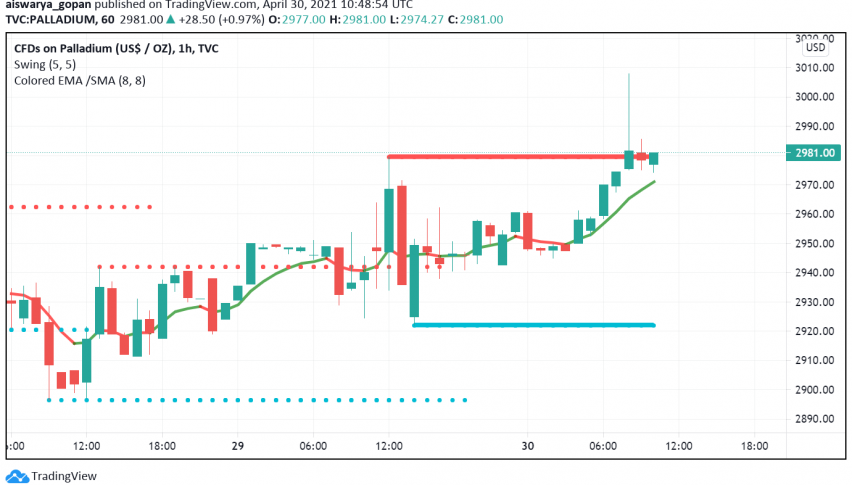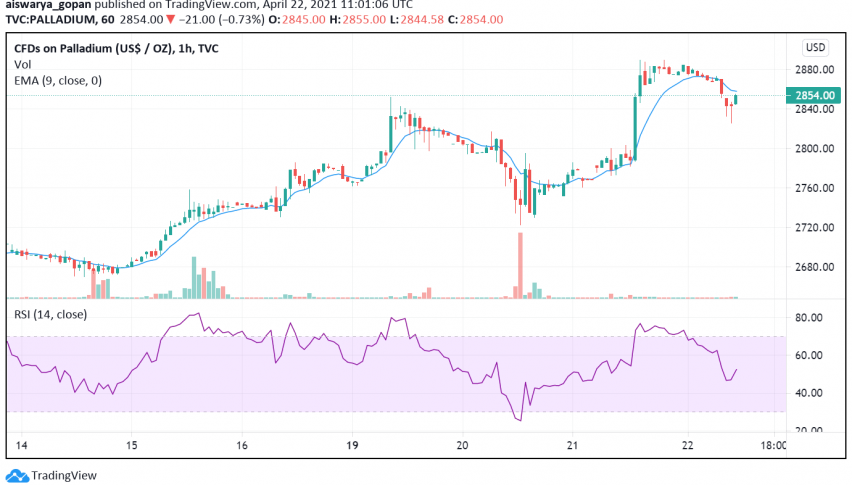Prices Forecast: Technical Analysis
For the daily forecast, Palladium is expected to close around $1,145, with a potential range between $1,131 and $1,152. The weekly forecast suggests a closing price of approximately $1,150, with a range from $1,124 to $1,166. The RSI at 61.95 indicates a slightly bullish momentum, suggesting that the price might continue to rise. The ATR of 25.37 points to moderate volatility, which could lead to price fluctuations within the predicted range. The MACD histogram shows a positive value, supporting the bullish outlook. However, the ADX at 24.17 suggests a weak trend, indicating that the price might not sustain a strong directional move. The pivot point at $1,145 is crucial, as trading above it could confirm the bullish sentiment.
Fundamental Overview and Analysis
Palladium has shown a steady upward trend recently, driven by strong demand in the automotive industry for catalytic converters. The asset’s value is influenced by supply constraints from major producers like Russia and South Africa. Investor sentiment remains positive, as reflected in the recent price increases. However, the market faces challenges such as potential regulatory changes in emissions standards and competition from alternative technologies. Despite these risks, Palladium’s current valuation appears fair, given its critical role in reducing vehicle emissions. The asset’s future growth opportunities lie in expanding automotive markets and stricter environmental regulations. However, market volatility and geopolitical tensions could pose risks to its price stability.
Outlook for Palladium
The future outlook for Palladium remains cautiously optimistic. Short-term trends suggest a potential price increase, driven by ongoing demand and limited supply. Over the next 1 to 6 months, Palladium could see moderate gains, with prices potentially reaching $1,200 if current conditions persist. Long-term forecasts (1 to 5 years) indicate steady growth, supported by increasing environmental regulations and technological advancements. However, external factors such as geopolitical issues or a market downturn could significantly impact prices. Investors should monitor economic conditions and industry developments closely, as these will play a crucial role in shaping Palladium’s future trajectory.
Technical Analysis
Current Price Overview: The current price of Palladium is $1,138, slightly below the previous close of $1,138. Over the last 24 hours, the price has shown a slight upward trend with moderate volatility, as indicated by the ATR.
Support and Resistance Levels: Key support levels are at $1,131, $1,124, and $1,110, while resistance levels are at $1,152, $1,166, and $1,173. The pivot point is at $1,145, and Palladium is trading just below it, suggesting a cautious bullish sentiment.
Technical Indicators Analysis: The RSI at 61.95 suggests a bullish trend, while the ATR indicates moderate volatility. The ADX at 24.17 shows a weak trend strength. The 50-day SMA is above the 200-day EMA, indicating a bullish crossover.
Market Sentiment & Outlook: Sentiment is cautiously bullish, with the price action near the pivot, a bullish RSI, and a recent moving average crossover. However, the weak ADX suggests limited trend strength, and investors should be prepared for potential volatility.
Forecasting Returns: $1,000 Across Market Conditions
Investing $1,000 in Palladium could yield different outcomes based on market conditions. In a Bullish Breakout scenario, a 10% price increase could raise the investment to approximately $1,100. In a Sideways Range, the price might remain stable, keeping the investment around $1,000. In a Bearish Dip, a 5% decrease could reduce the investment to about $950. These scenarios highlight the importance of understanding market dynamics and potential risks. Investors should consider diversifying their portfolios and setting stop-loss orders to manage risk effectively.
| Scenario | Price Change | Value After 1 Month |
|---|---|---|
| Bullish Breakout | +10% to ~$1,252 | ~$1,100 |
| Sideways Range | 0% to ~$1,145 | ~$1,000 |
| Bearish Dip | -5% to ~$1,088 | ~$950 |
FAQs
What are the predicted price forecasts for the asset?
The daily forecast for Palladium suggests a closing price around $1,145, with a range between $1,131 and $1,152. The weekly forecast anticipates a closing price of approximately $1,150, with a range from $1,124 to $1,166.
What are the key support and resistance levels for the asset?
Key support levels for Palladium are at $1,131, $1,124, and $1,110. Resistance levels are identified at $1,152, $1,166, and $1,173. The pivot point is at $1,145, which is crucial for determining market sentiment.
What are the main factors influencing the asset’s price?
Palladium’s price is influenced by strong demand in the automotive industry, supply constraints from major producers, and investor sentiment. Regulatory changes and competition from alternative technologies also play a role in shaping its value.
What is the outlook for the asset in the next 1 to 6 months?
In the next 1 to 6 months, Palladium is expected to see moderate gains, potentially reaching $1,200 if current demand and supply conditions persist. However, external factors such as geopolitical issues could impact its price trajectory.
Disclaimer
In conclusion, while the analysis provides a structured outlook on the asset’s potential price movements, it is essential to remember that financial markets are inherently unpredictable. Conducting thorough research and staying informed about market trends and economic indicators is crucial for making informed investment decisions.


